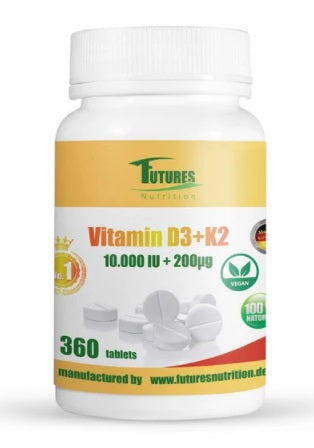
Taking Vitamin D3
Share
Intake Vitamin D3 2022

Vitamin D3 is included in the form of colecalciferol. A doctor can prescribe it if your vitamin D3 mirror is too low. Both the calcium intake from the stomach and the calcium function in the body are dependent on vitamin D3.
Even if you have no symptoms, a lack of vitamin D3 can lead to widespread pain. Osteoporosis and brittle bones are favored by a lack of vitamin D3. COLECALCIFEROL helps with the reception of calcium from the food.
In addition to the soft gelatin capsules (1.25 milligrams) and the liquid, colecalciferol is also available. The combination of cholecalciferol and alendronate is also available in a lower dosage. To treat osteoporosis, this drug is administered once a week.
Who can need cholecalciferol?
A vitamin D3 deficiency can justify the prescription of cholecalciferol by your doctor. As soon as your body is exposed to sunlight, he produces vitamin D3. Vitamin D3 Can be won by most people in this way. In addition to fat fish (salmon, tuna, mackerel) and margarine (milk), certain milk also contains a modest amount of vitamin D3.

In the winter months, the vitamin D3 concentration is lowest. The vitamin D3 mirror in women is usually lower than men. With increasing age, the sunlight decreases and the ability to form vitamin D3 decreases. The vitamin D3 mirror is in people with darker skin color, z. As Africans and Indians, lower. The vitamin D3 mirror is lower for fat people than not fat people.
Vitamin D Dose - Intake Vitamin D3
A cholecalciferol capsule should be taken as a standard dose once a month. Take two capsules for the first time, then a capsule once a month. If your vitamin D3 mirror is insufficient, you may need to take a capsule per day for ten days, then a capsule per month. If you suffer from liver disease, you may still need to take a daily supplement. In addition, your doctor may ask you to take a sufficient amount of calcium over the food.
Follow the instructions of your doctor when taking Cholecalciferol. Detailed dosage instructions, recommendations on the frequency of ingestion and other relevant information can be found on the pharmaceutical label on the outside of the bottle.
How to take Cholecalciferol
You can take cholecalciferol once a month, for example on the first or last day of each month, if your doctor has recommended you this. It is possible to take cholecalciferol without food.
Do not wait until the next day if you forgot to take your drug. However, you can take the next dose on the right day when the time of ingestion is close. Do not increase the dose. COLECALCIFEROL should be taken with caution. Does your body react to peanuts or soy?
Do you suffer from kidney problems? Do you have a high calcium content in your body? Do you use prescription and over-the-counter drugs as well as herbal or supplementary medicines?
If this is the case, you must inform your doctor or pharmacist before starting a treatment with cholecalciferol. The ingestion of certain medicines may be unsuitable for people with certain diseases, or it is safe only under certain conditions.
Blood examinations and monitoring
In most patients, no blood test is required at the beginning of taking colecalciferol. Your doctor can prescribe you colecalciferol if your risk for one Vitamin D3 deficiency (an insufficient supply of vitamin D3) is high. The vitamin D3 mirror must not be monitored when taking colecalciferol, as it is safe.

Fat-soluble vitamins
The fat-soluble vitamins include vitamins A, D, E and K. Vitamin A ensures normal visual function, nourishes, strengths skin and mucous membranes, improves skin elasticity, strengthens the bones and the immune system. Vitamin E acts as antioxidant, improves skin and mucous membranes and contributes to protecting cardiovascular diseases. Vitamin D is one of the most popular vitamins recent, as people in autumn / winter spend most of the day in closed rooms in the spring / summer but rightly try the time in which they are the direct ultraviolet radiation of the sun expose to limit. Recent studies show that 85% of the Latvian population have a low vitamin D mirror, especially during the winter season. It is involved in numerous metabolic processes and calcium intake in the bone and reduces the symptoms of some chronic diseases (high blood pressure, asthma, Alzheimer's). Vitamin K Proper blood clotting in the body, which is especially important for newborns, for proper bone mineralization, improves the penetration of calcium ions into the bones and can reduce the risk of arteriosclerosis.
Tips for use

The fat-soluble vitamin D, which is currently so announced, should be taken in the morning. One of the reasons for this is that it increases our ability to work and supplies us energy and involved in calcium recording. However, since the vitamin reserves are stored in the liver, it is recommended to take the other vitamins of this group - A, E, K - with dinner. So that they can be better absorbed by the body, they should be taken together with products that contain saturated fats or oils (dairy products, meat, etc.). Magnesium preparations are also recommended in the evening because magnesium is absorbed in the gastrointestinal tract, promoting healthy sleep and prevents nocturnal cramps.
When should multivitamines be taken?
Multivitamines should be taken after lunch. On the one hand, the midday meal is usually more extensive than breakfast, on the other hand, many people with chronic diseases must take important medications (eg to blood pressure reduction) right in the morning.
